1999 TOYOTA CAMRY ignition
[x] Cancel search: ignitionPage 4068 of 4592

This system utilizes an engine control module and maintains overall control of the engine, transmission and so on. An outline
of the engine control is explained here.
1. INPUT SIGNALS
(1) Engine coolant temp. signal circuit
The engine coolant temp. sensor detects the engine coolant temp. and has a built±in thermistor with a resistance which
varies according to the engine coolant temp. thus the engine coolant temp. is input in the form of a control signal into
TERMINAL THW of the engine control module.
(2) Intake air temp. signal circuit
The intake air temp. sensor detects the intake air temp. , which is input as a control signal into TERMINAL THA of the
engine control module.
(3) Oxygen sensor signal circuit
The oxygen density in the exhaust gases is detected and input as a control signal into TERMINAL OX2 of the engine
control module.
(4) RPM signal circuit
Camshaft position and crankshaft position are detected by the camshaft position sensor and crankshaft position sensor.
Camshaft position is input as a control signal to TERMINAL G of the engine control module, and engine RPM is input
into TERMINAL NE.
(5) Throttle signal circuit
The throttle position sensor detects the throttle valve opening angle, which is input as a control signal into TERMINAL
VTA of the engine control module.
(6) Vehicle speed signal circuit
The vehicle speed sensor, installed inside the transmission, detects the vehicle speed and inputs a control signal into
TERMINAL SPD of the engine control module.
(7) Park/Neutral position SW signal circuit
The Park/Neutral position SW detects whether the shift position are in neutral, parking or not, and inputs a control signal
into TERMINAL STA of the engine control module.
(8) A/C SW signal circuit
The A/C amplifier is built in the engine control module. The signal from the A/C SW is input into TERMINAL A/CS of the
engine control module.
(9) Battery signal circuit
Voltage is constantly applied to TERMINAL BATT of the engine control module. When the ignition SW is turned on, the
voltage for engine control module start±up power supply is applied to TERMINAL +B of engine control module via EFI
relay.
(10) Intake air volume signal circuit
Intake air volume is detected by the manifold absolute pressure sensor (for manifold pressure) and is input as a control
signal into TERMINAL PIM of the engine control module.
(11) Starter signal circuit
To confirm whether the engine is cranking, the voltage applied to the starter motor during cranking is detected and the
signal is input into TERMINAL NSW of the engine control module as a control signal.
(12) Electrical load signal circuit
The signal when systems such as the rear window defogger, headlights, etc. Which cause a high electrical burden are
on is input to TERMINAL ELS as a control signal.
(13) Air fuel ratio signal circuit
The air fuel ratio is detected and input as a control signal into TERMINAL AF+ of the engine control module.
SYSTEM OUTLINE
Page 4069 of 4592
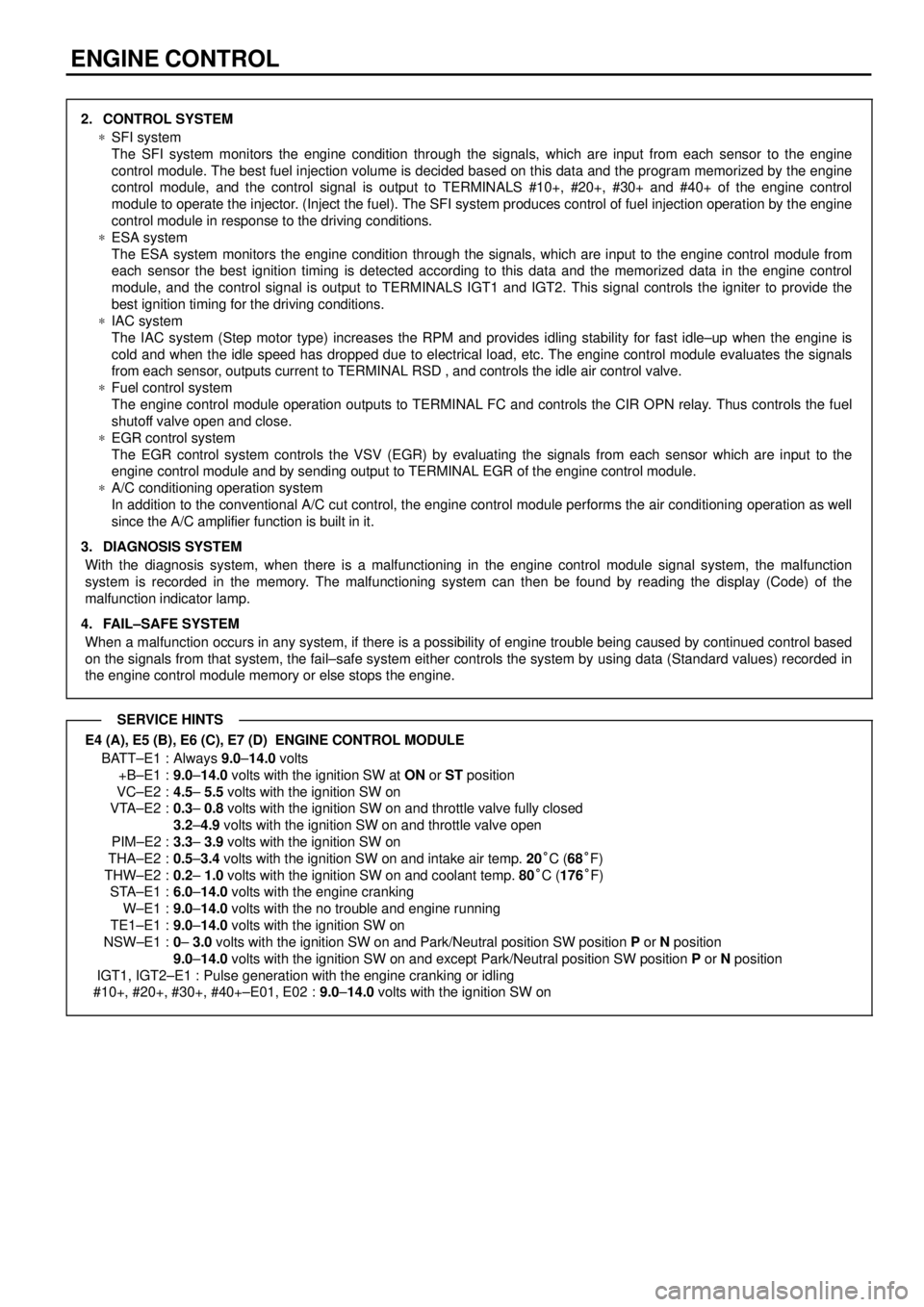
ENGINE CONTROL
2. CONTROL SYSTEM
*SFI system
The SFI system monitors the engine condition through the signals, which are input from each sensor to the engine
control module. The best fuel injection volume is decided based on this data and the program memorized by the engine
control module, and the control signal is output to TERMINALS #10+, #20+, #30+ and #40+ of the engine control
module to operate the injector. (Inject the fuel). The SFI system produces control of fuel injection operation by the engine
control module in response to the driving conditions.
*ESA system
The ESA system monitors the engine condition through the signals, which are input to the engine control module from
each sensor the best ignition timing is detected according to this data and the memorized data in the engine control
module, and the control signal is output to TERMINALS IGT1 and IGT2. This signal controls the igniter to provide the
best ignition timing for the driving conditions.
*IAC system
The IAC system (Step motor type) increases the RPM and provides idling stability for fast idle±up when the engine is
cold and when the idle speed has dropped due to electrical load, etc. The engine control module evaluates the signals
from each sensor, outputs current to TERMINAL RSD , and controls the idle air control valve.
*Fuel control system
The engine control module operation outputs to TERMINAL FC and controls the CIR OPN relay. Thus controls the fuel
shutoff valve open and close.
*EGR control system
The EGR control system controls the VSV (EGR) by evaluating the signals from each sensor which are input to the
engine control module and by sending output to TERMINAL EGR of the engine control module.
*A/C conditioning operation system
In addition to the conventional A/C cut control, the engine control module performs the air conditioning operation as well
since the A/C amplifier function is built in it.
3. DIAGNOSIS SYSTEM
With the diagnosis system, when there is a malfunctioning in the engine control module signal system, the malfunction
system is recorded in the memory. The malfunctioning system can then be found by reading the display (Code) of the
malfunction indicator lamp.
4. FAIL±SAFE SYSTEM
When a malfunction occurs in any system, if there is a possibility of engine trouble being caused by continued control based
on the signals from that system, the fail±safe system either controls the system by using data (Standard values) recorded in
the engine control module memory or else stops the engine.
E4 (A), E5 (B), E6 (C), E7 (D) ENGINE CONTROL MODULE
BATT±E1 : Always 9.0±14.0 volts
+B±E1 :9.0±14.0 volts with the ignition SW at ON or ST position
VC±E2 :4.5± 5.5 volts with the ignition SW on
VTA±E2 :0.3± 0.8 volts with the ignition SW on and throttle valve fully closed
3.2±4.9 volts with the ignition SW on and throttle valve open
PIM±E2 :3.3± 3.9 volts with the ignition SW on
THA±E2 :0.5±3.4 volts with the ignition SW on and intake air temp. 20°C (68°F)
THW±E2 :0.2± 1.0 volts with the ignition SW on and coolant temp. 80°C (176°F)
STA±E1 :6.0±14.0 volts with the engine cranking
W±E1 :9.0±14.0 volts with the no trouble and engine running
TE1±E1 :9.0±14.0 volts with the ignition SW on
NSW±E1 :0± 3.0 volts with the ignition SW on and Park/Neutral position SW position P or N position
9.0±14.0 volts with the ignition SW on and except Park/Neutral position SW position P or N position
IGT1, IGT2±E1 : Pulse generation with the engine cranking or idling
#10+, #20+, #30+, #40+±E01, E02 :9.0±14.0 volts with the ignition SW on
SERVICE HINTS
Page 4076 of 4592
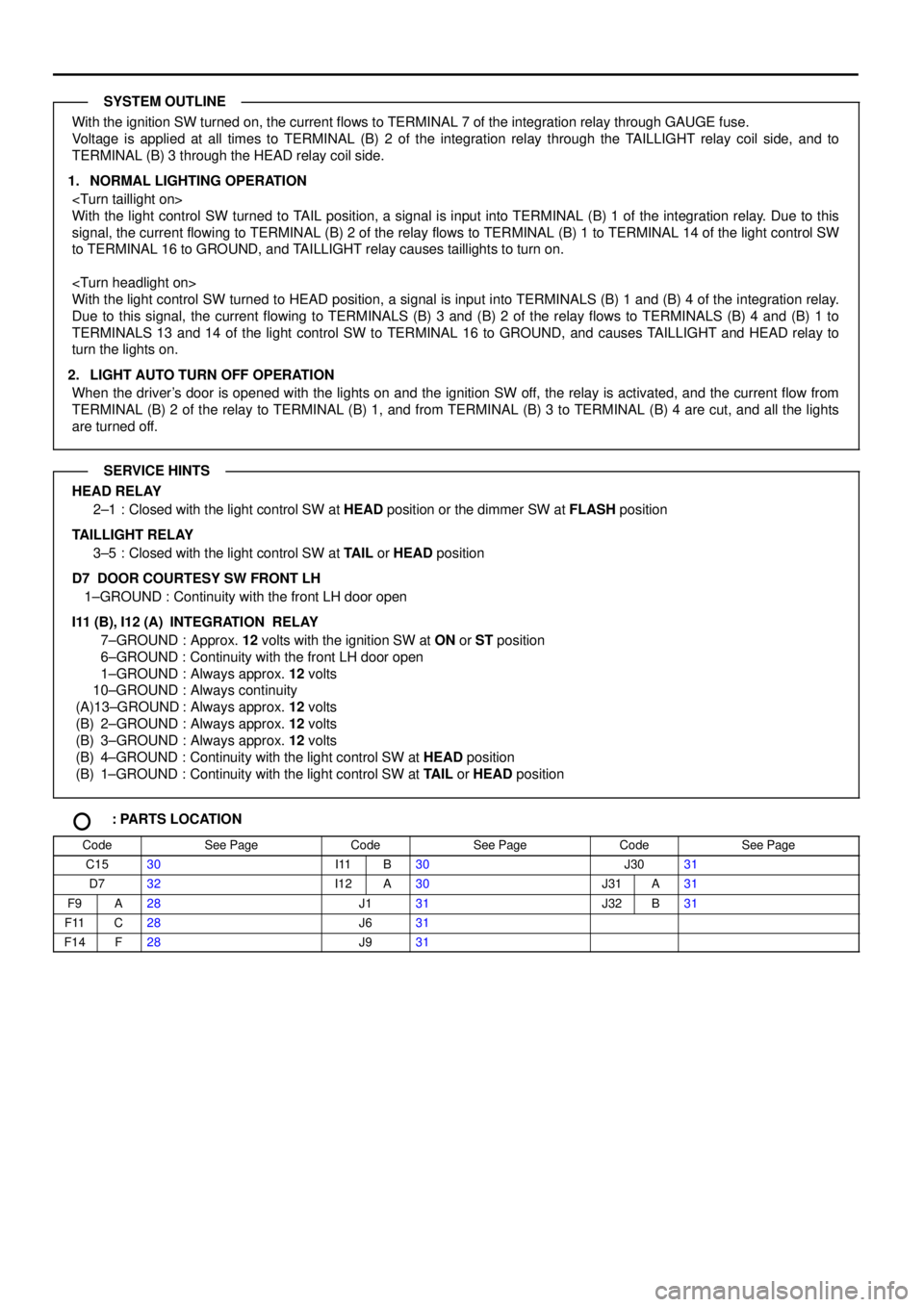
With the ignition SW turned on, the current flows to TERMINAL 7 of the integration relay through GAUGE fuse.
Voltage is applied at all times to TERMINAL (B) 2 of the integration relay through the TAILLIGHT relay coil side, and to
TERMINAL (B) 3 through the HEAD relay coil side.
1. NORMAL LIGHTING OPERATION
With the light control SW turned to TAIL position, a signal is input into TERMINAL (B) 1 of the integration relay. Due to this
signal, the current flowing to TERMINAL (B) 2 of the relay flows to TERMINAL (B) 1 to TERMINAL 14 of the light control SW
to TERMINAL 16 to GROUND, and TAILLIGHT relay causes taillights to turn on.
With the light control SW turned to HEAD position, a signal is input into TERMINALS (B) 1 and (B) 4 of the integration relay.
Due to this signal, the current flowing to TERMINALS (B) 3 and (B) 2 of the relay flows to TERMINALS (B) 4 and (B) 1 to
TERMINALS 13 and 14 of the light control SW to TERMINAL 16 to GROUND, and causes TAILLIGHT and HEAD relay to
turn the lights on.
2. LIGHT AUTO TURN OFF OPERATION
When the driver's door is opened with the lights on and the ignition SW off, the relay is activated, and the current flow from
TERMINAL (B) 2 of the relay to TERMINAL (B) 1, and from TERMINAL (B) 3 to TERMINAL (B) 4 are cut, and all the lights
are turned off.
HEAD RELAY
2±1 : Closed with the light control SW at HEAD position or the dimmer SW at FLASH position
TAILLIGHT RELAY
3±5 : Closed with the light control SW at TAIL or HEAD position
D7 DOOR COURTESY SW FRONT LH
1±GROUND : Continuity with the front LH door open
I11 (B), I12 (A)
INTEGRATION RELAY
7±GROUND : Approx. 12 volts with the ignition SW at ON or ST position
6±GROUND : Continuity with the front LH door open
1±GROUND : Always approx. 12 volts
10±GROUND : Always continuity
(A)13±GROUND : Always approx. 12 volts
(B) 2±GROUND : Always approx. 12 volts
(B) 3±GROUND : Always approx. 12 volts
(B) 4±GROUND : Continuity with the light control SW at HEAD position
(B) 1±GROUND : Continuity with the light control SW at TAIL or HEAD position
: PARTS LOCATION
CodeSee PageCodeSee PageCodeSee Page
C1530I11B30J3031
D732I12A30J31A31
F9A28J131J32B31
F11C28J631
F14F28J931
SYSTEM OUTLINE
SERVICE HINTS
Page 4080 of 4592
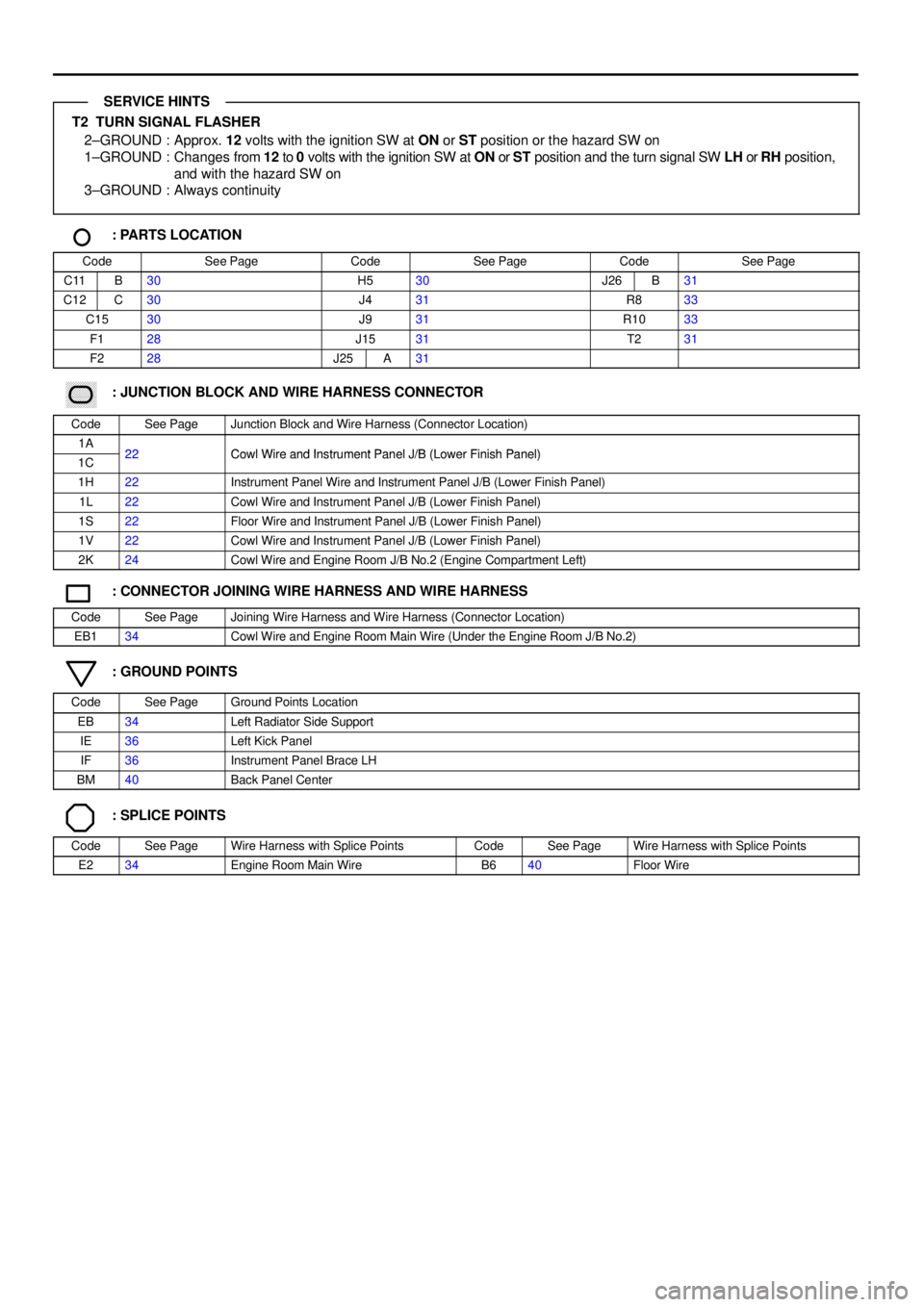
T2 TURN SIGNAL FLASHER
2±GROUND : Approx. 12 volts with the ignition SW at ON or ST position or the hazard SW on
1±GROUND : Changes from 12 to 0 volts with the ignition SW at ON or ST position and the turn signal SW LH or RH position,
and with the hazard SW on
3±GROUND : Always continuity
: PARTS LOCATION
CodeSee PageCodeSee PageCodeSee Page
C11B30H530J26B31
C12C30J431R833
C1530J931R1033
F128J1531T231
F228J25A31
������ ���: JUNCTION BLOCK AND WIRE HARNESS CONNECTOR
CodeSee PageJunction Block and Wire Harness (Connector Location)
1A22Cowl Wire and Instrument Panel J/B (Lower Finish Panel)1C22Cowl Wire and Instrument Panel J/B (Lower Finish Panel)
1H22Instrument Panel Wire and Instrument Panel J/B (Lower Finish Panel)
1L22Cowl Wire and Instrument Panel J/B (Lower Finish Panel)
1S22Floor Wire and Instrument Panel J/B (Lower Finish Panel)
1V22Cowl Wire and Instrument Panel J/B (Lower Finish Panel)
2K24Cowl Wire and Engine Room J/B No.2 (Engine Compartment Left)
: CONNECTOR JOINING WIRE HARNESS AND WIRE HARNESS
CodeSee PageJoining Wire Harness and Wire Harness (Connector Location)
EB134Cowl Wire and Engine Room Main Wire (Under the Engine Room J/B No.2)
: GROUND POINTS
CodeSee PageGround Points Location
EB34Left Radiator Side Support
IE36Left Kick Panel
IF36Instrument Panel Brace LH
BM40Back Panel Center
: SPLICE POINTS
CodeSee PageWire Harness with Splice PointsCodeSee PageWire Harness with Splice Points
E234Engine Room Main WireB640Floor Wire
SERVICE HINTS
Page 4082 of 4592
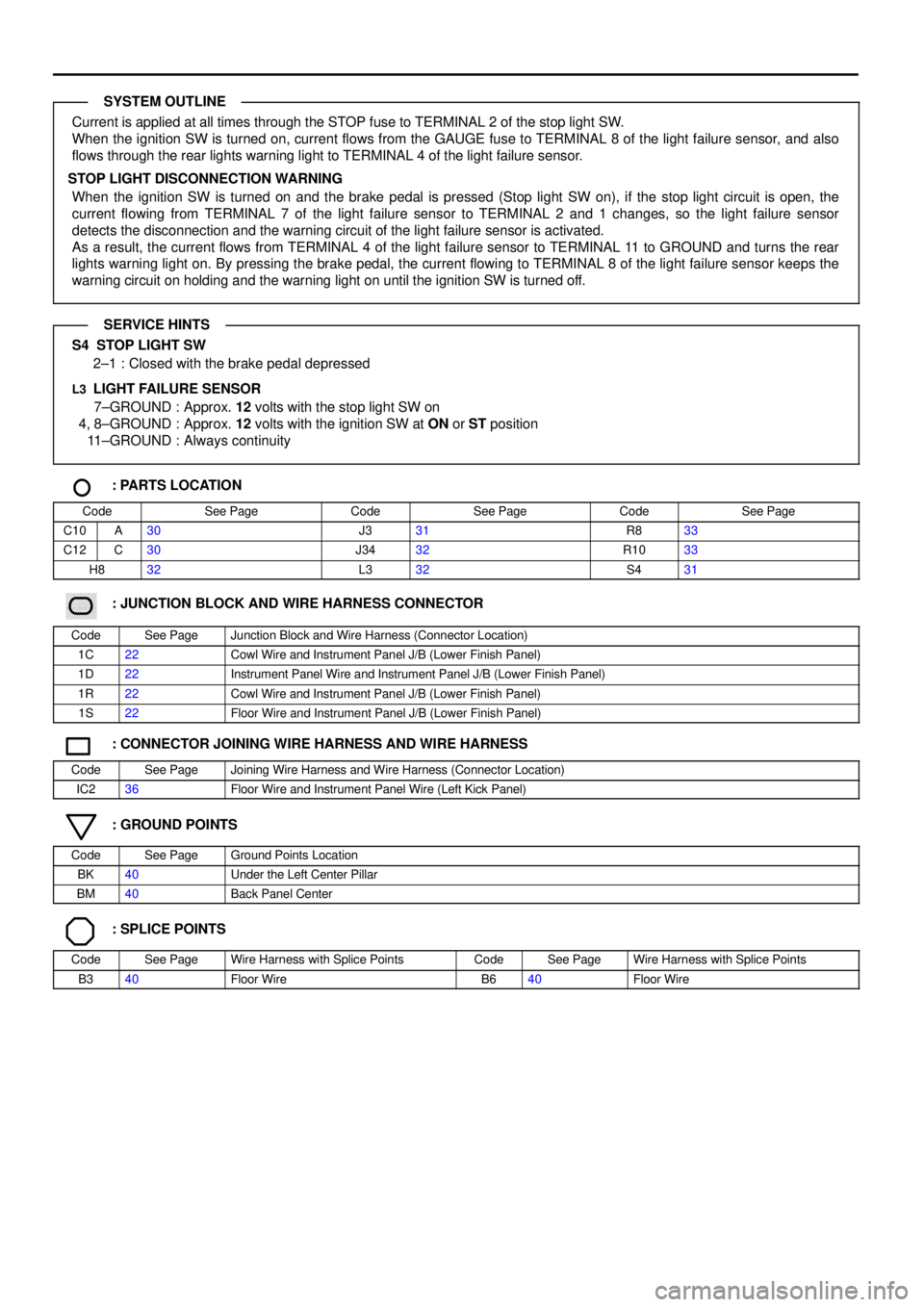
Current is applied at all times through the STOP fuse to TERMINAL 2 of the stop light SW.
When the ignition SW is turned on, current flows from the GAUGE fuse to TERMINAL 8 of the light failure sensor, and also
flows through the rear lights warning light to TERMINAL 4 of the light failure sensor.
STOP LIGHT DISCONNECTION WARNING
When the ignition SW is turned on and the brake pedal is pressed (Stop light SW on), if the stop light circuit is open, the
current flowing from TERMINAL 7 of the light failure sensor to TERMINAL 2 and 1 changes, so the light failure sensor
detects the disconnection and the warning circuit of the light failure sensor is activated.
As a result, the current flows from TERMINAL 4 of the light failure sensor to TERMINAL 11 to GROUND and turns the rear
lights warning light on. By pressing the brake pedal, the current flowing to TERMINAL 8 of the light failure sensor keeps the
warning circuit on holding and the warning light on until the ignition SW is turned off.
S4 STOP LIGHT SW
2±1 : Closed with the brake pedal depressed
L3 LIGHT FAILURE SENSOR
7±GROUND : Approx. 12 volts with the stop light SW on
4, 8±GROUND : Approx. 12 volts with the ignition SW at ON or ST position
11±GROUND : Always continuity
: PARTS LOCATION
CodeSee PageCodeSee PageCodeSee Page
C10A30J331R833
C12C30J3432R1033
H832L332S431
������ ���: JUNCTION BLOCK AND WIRE HARNESS CONNECTOR
CodeSee PageJunction Block and Wire Harness (Connector Location)
1C22Cowl Wire and Instrument Panel J/B (Lower Finish Panel)
1D22Instrument Panel Wire and Instrument Panel J/B (Lower Finish Panel)
1R22Cowl Wire and Instrument Panel J/B (Lower Finish Panel)
1S22Floor Wire and Instrument Panel J/B (Lower Finish Panel)
: CONNECTOR JOINING WIRE HARNESS AND WIRE HARNESS
CodeSee PageJoining Wire Harness and Wire Harness (Connector Location)
IC236Floor Wire and Instrument Panel Wire (Left Kick Panel)
: GROUND POINTS
CodeSee PageGround Points Location
BK40Under the Left Center Pillar
BM40Back Panel Center
: SPLICE POINTS
CodeSee PageWire Harness with Splice PointsCodeSee PageWire Harness with Splice Points
B340Floor WireB640Floor Wire
SYSTEM OUTLINE
SERVICE HINTS
Page 4084 of 4592
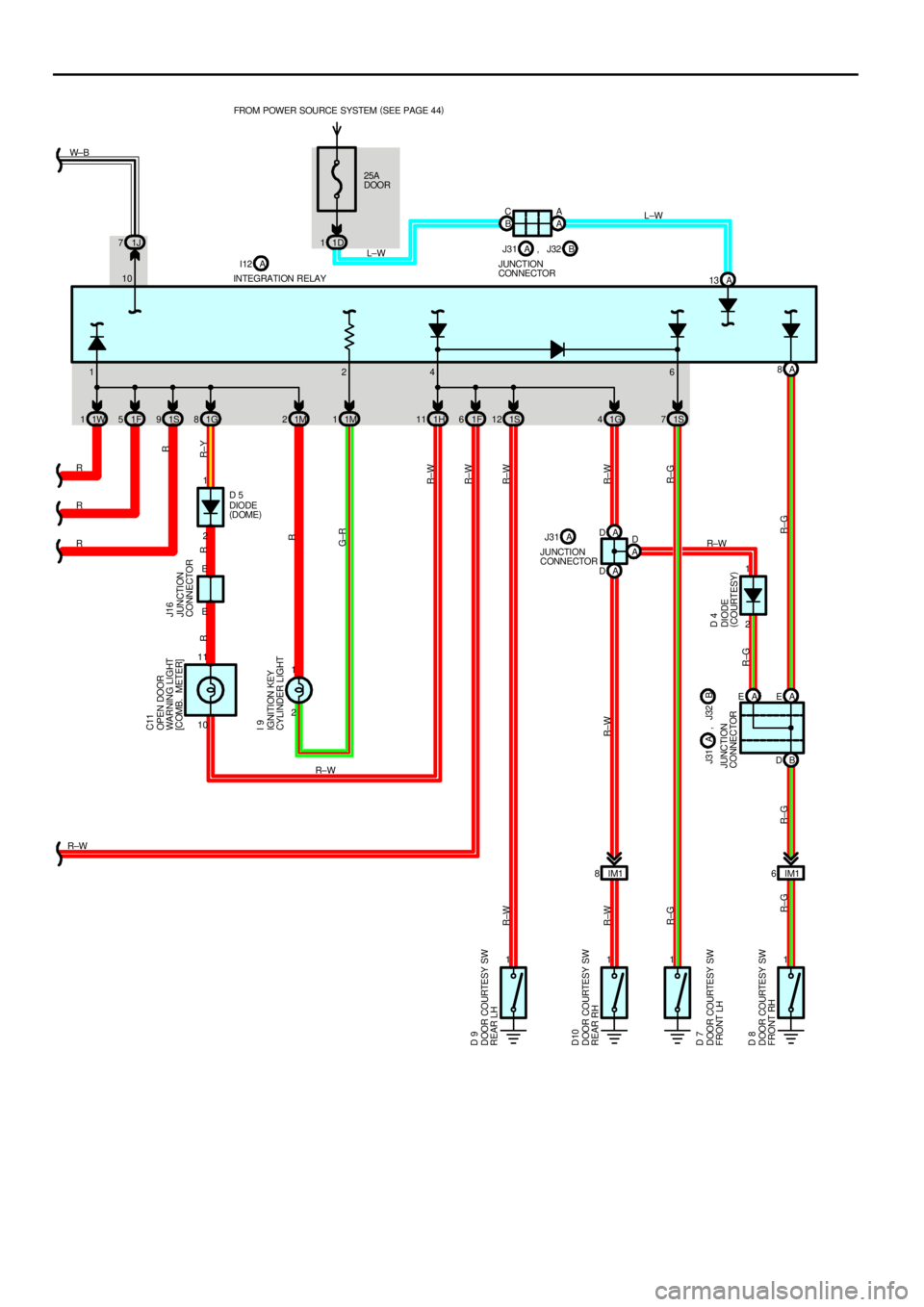
2 1
10 11
111 1 1W 11F51S91G81M21M11H11 1F61S12 1G41S7 1J 7
A 8
B DA E A E
IM1 8IM16 2 1 126 10
R±WR R R W± B
R±W
R±W
R
R±Y
R
G±R
R±W
R±W
R±W
R±W
R±G
R±G R±G
R±G R±GR±W R±W
R±G R±W
INTEGRATION RELAYA
JUNCTION
CONNECTOR
I 9
IGNITION KEY
CYLINDER LIGHTJUNCTION
CONNECTOR OPEN DOOR
WAR NIN G LI GHT
[COMB. METER]
DIODE
(
COURTESY) J16 C11
D 4 DOOR COURTESY SW
FRONT LH
DOOR COURTESY SW
FRONT RH DOOR COURTESY SW
REAR RH DOOR COURTESY SW
REAR LH D 9
D10
D 7
D 8
4
2 1
DIODE
(
DOME) D 5
A
A D
J31
JUNCTION
CONNECTORB A, J32
I12
J31
E EA D
A D 25A
DOOR FROM POWER SOURCE SYSTEM (
SEE PAGE 44)
1D 1B C
A 13 L±WL±W
J31
JUNCTION
CONNECTORB A, J32A A
R R
Page 4093 of 4592
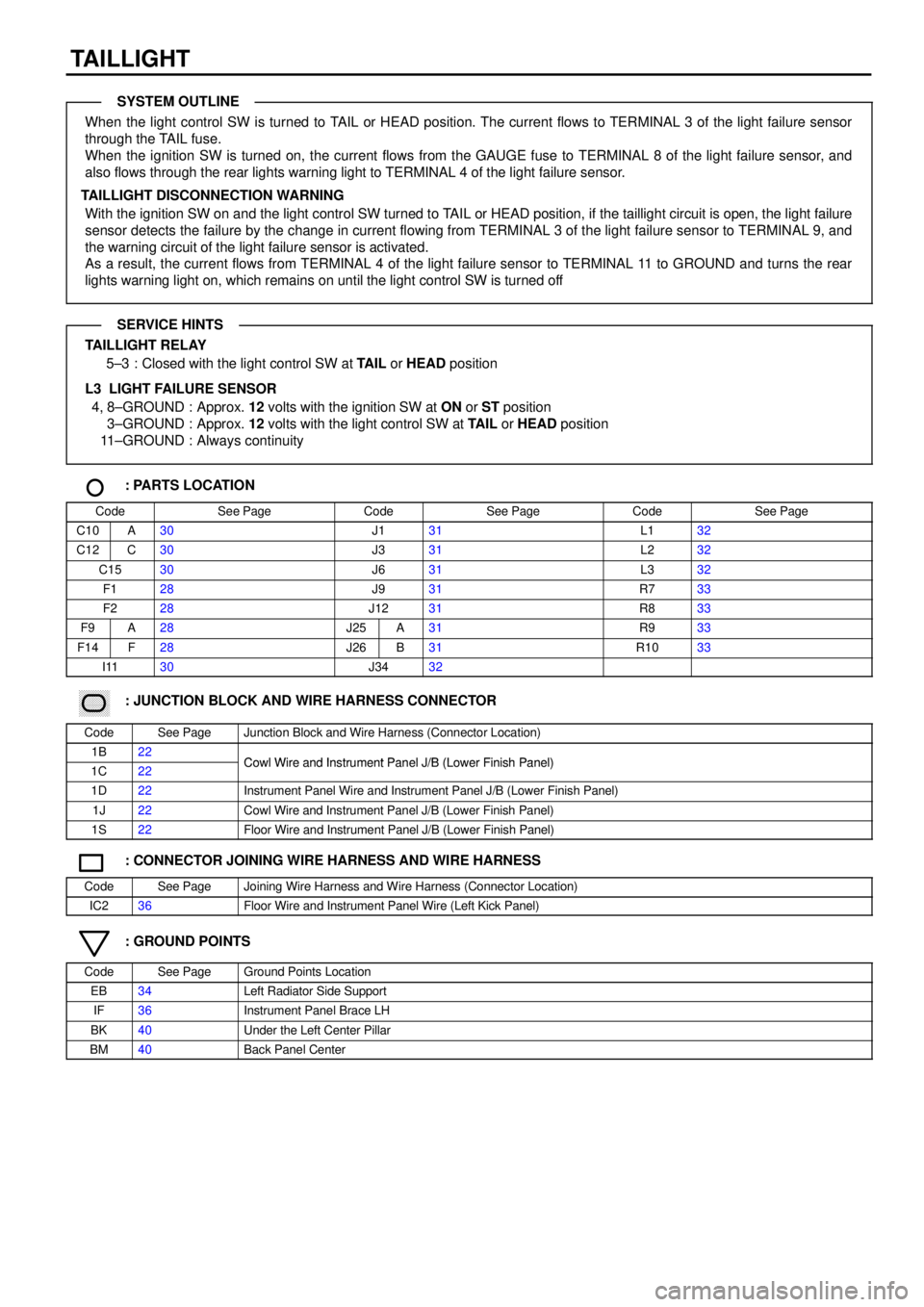
TAILLIGHT
When the light control SW is turned to TAIL or HEAD position. The current flows to TERMINAL 3 of the light failure sensor
through the TAIL fuse.
When the ignition SW is turned on, the current flows from the GAUGE fuse to TERMINAL 8 of the light failure sensor, and
also flows through the rear lights warning light to TERMINAL 4 of the light failure sensor.
TAILLIGHT DISCONNECTION WARNING
With the ignition SW on and the light control SW turned to TAIL or HEAD position, if the taillight circuit is open, the light failure
sensor detects the failure by the change in current flowing from TERMINAL 3 of the light failure sensor to TERMINAL 9, and
the warning circuit of the light failure sensor is activated.
As a result, the current flows from TERMINAL 4 of the light failure sensor to TERMINAL 11 to GROUND and turns the rear
lights warning light on, which remains on until the light control SW is turned off
TAILLIGHT RELAY
5±3 : Closed with the light control SW at TAIL or HEAD position
L3 LIGHT FAILURE SENSOR
4, 8±GROUND : Approx. 12 volts with the ignition SW at ON or ST position
3±GROUND : Approx. 12 volts with the light control SW at TAIL or HEAD position
11±GROUND : Always continuity
: PARTS LOCATION
CodeSee PageCodeSee PageCodeSee Page
C10A30J131L132
C12C30J331L232
C1530J631L332
F128J931R733
F228J1231R833
F9A28J25A31R933
F14F28J26B31R1033
I1130J3432
������ ���: JUNCTION BLOCK AND WIRE HARNESS CONNECTOR
CodeSee PageJunction Block and Wire Harness (Connector Location)
1B22Cowl Wire and Instrument Panel J/B (Lower Finish Panel)1C22Cowl Wire and Instrument Panel J/B (Lower Finish Panel)
1D22Instrument Panel Wire and Instrument Panel J/B (Lower Finish Panel)
1J22Cowl Wire and Instrument Panel J/B (Lower Finish Panel)
1S22Floor Wire and Instrument Panel J/B (Lower Finish Panel)
: CONNECTOR JOINING WIRE HARNESS AND WIRE HARNESS
CodeSee PageJoining Wire Harness and Wire Harness (Connector Location)
IC236Floor Wire and Instrument Panel Wire (Left Kick Panel)
: GROUND POINTS
CodeSee PageGround Points Location
EB34Left Radiator Side Support
IF36Instrument Panel Brace LH
BK40Under the Left Center Pillar
BM40Back Panel Center
SYSTEM OUTLINE
SERVICE HINTS
Page 4098 of 4592
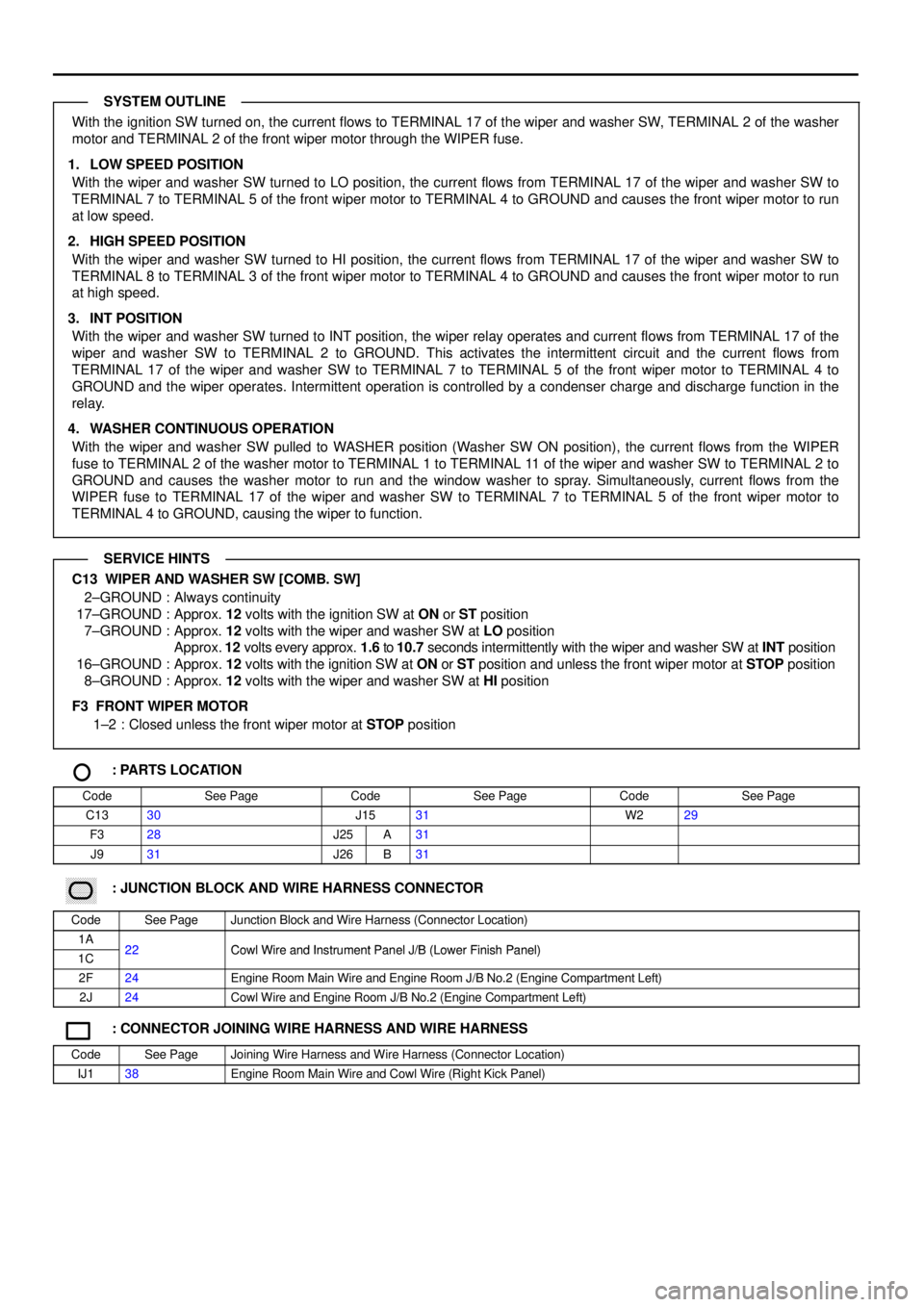
With the ignition SW turned on, the current flows to TERMINAL 17 of the wiper and washer SW, TERMINAL 2 of the washer
motor and TERMINAL 2 of the front wiper motor through the WIPER fuse.
1. LOW SPEED POSITION
With the wiper and washer SW turned to LO position, the current flows from TERMINAL 17 of the wiper and washer SW to
TERMINAL 7 to TERMINAL 5 of the front wiper motor to TERMINAL 4 to GROUND and causes the front wiper motor to run
at low speed.
2. HIGH SPEED POSITION
With the wiper and washer SW turned to HI position, the current flows from TERMINAL 17 of the wiper and washer SW to
TERMINAL 8 to TERMINAL 3 of the front wiper motor to TERMINAL 4 to GROUND and causes the front wiper motor to run
at high speed.
3. INT POSITION
With the wiper and washer SW turned to INT position, the wiper relay operates and current flows from TERMINAL 17 of the
wiper and washer SW to TERMINAL 2 to GROUND. This activates the intermittent circuit and the current flows from
TERMINAL 17 of the wiper and washer SW to TERMINAL 7 to TERMINAL 5 of the front wiper motor to TERMINAL 4 to
GROUND and the wiper operates. Intermittent operation is controlled by a condenser charge and discharge function in the
relay.
4. WASHER CONTINUOUS OPERATION
With the wiper and washer SW pulled to WASHER position (Washer SW ON position), the current flows from the WIPER
fuse to TERMINAL 2 of the washer motor to TERMINAL 1 to TERMINAL 11 of the wiper and washer SW to TERMINAL 2 to
GROUND and causes the washer motor to run and the window washer to spray. Simultaneously, current flows from the
WIPER fuse to TERMINAL 17 of the wiper and washer SW to TERMINAL 7 to TERMINAL 5 of the front wiper motor to
TERMINAL 4 to GROUND, causing the wiper to function.
C13 WIPER AND WASHER SW [COMB. SW]
2±GROUND : Always continuity
17±GROUND : Approx. 12 volts with the ignition SW at ON or ST position
7±GROUND : Approx. 12 volts with the wiper and washer SW at LO position
Approx. 12 volts every approx. 1.6 to 10.7 seconds intermittently with the wiper and washer SW at INT position
16±GROUND : Approx. 12 volts with the ignition SW at ON or ST position and unless the front wiper motor at STOP position
8±GROUND : Approx. 12 volts with the wiper and washer SW at HI position
F3 FRONT WIPER MOTOR
1±2 : Closed unless the front wiper motor at STOP position
: PARTS LOCATION
CodeSee PageCodeSee PageCodeSee Page
C1330J1531W229
F328J25A31
J931J26B31
������ ���: JUNCTION BLOCK AND WIRE HARNESS CONNECTOR
CodeSee PageJunction Block and Wire Harness (Connector Location)
1A22Cowl Wire and Instrument Panel J/B (Lower Finish Panel)1C22Cowl Wire and Instrument Panel J/B (Lower Finish Panel)
2F24Engine Room Main Wire and Engine Room J/B No.2 (Engine Compartment Left)
2J24Cowl Wire and Engine Room J/B No.2 (Engine Compartment Left)
: CONNECTOR JOINING WIRE HARNESS AND WIRE HARNESS
CodeSee PageJoining Wire Harness and Wire Harness (Connector Location)
IJ138Engine Room Main Wire and Cowl Wire (Right Kick Panel)
SYSTEM OUTLINE
SERVICE HINTS